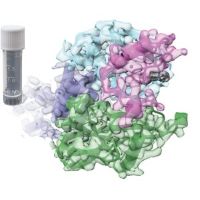Specification
| Description | Recombinant protein from the full-length sequence of homo sapiens egl-9 family hypoxia-inducible factor 1 (EGLN1) (NM_022051). |
| Organism | Homo sapiens (Human) |
| Expression Host | Human Cells |
| Tag Info | His or DYKDDDDK. Please contact us if you need further information or require specific designed tag. |
| Purity | Greater than 90% by SDS-PAGE gel |
| Uniprot ID | Q9GZT9 |
| Entry Name | EGLN1_HUMAN |
| Gene Names | EGLN1 C1orf12 PNAS-118 PNAS-137 |
| Alternative Gene Names | C1orf12 |
| Alternative Protein Names | Egl nine homolog 1 (EC 1.14.11.29) (Hypoxia-inducible factor prolyl hydroxylase 2) (HIF-PH2) (HIF-prolyl hydroxylase 2) (HPH-2) (Prolyl hydroxylase domain-containing protein 2) (PHD2) (SM-20) |
| Application | Antigens, Western, ELISA and other in vitro binding or in vivo functional assays, and protein-protein interaction studies; For research & development use only! |
| Buffer | Purified protein formulated in a sterile solution of PBS buffer, pH7.2, without any preservatives |
| Endotoxin | Endotoxin level is < 0.1 ng/µg of protein (<1EU /µg) |
| Length | 426 |
| Molecular Weight(Da) | 46021 |
| Protein Sequence | (The sequence of expressed protein may have some variation from the sequence shown below. Please contact us for the exact sequence.) MANDSGGPGGPSPSERDRQYCELCGKMENLLRCSRCRSSFYCCKEHQRQDWKKHKLVCQGSEGALGHGVGPHQHSGPAPPAAVPPPRAGAREPRKAAARRDNASGDAAKGKVKAKPPADPAAAASPCRAAAGGQGSAVAAEAEPGKEEPPARSSLFQEKANLYPPSNTPGDALSPGGGLRPNGQTKPLPALKLALEYIVPCMNKHGICVVDDFLGKETGQQIGDEVRALHDTGKFTDGQLVSQKSDSSKDIRGDKITWIEGKEPGCETIGLLMSSMDDLIRHCNGKLGSYKINGRTKAMVACYPGNGTGYVRHVDNPNGDGRCVTCIYYLNKDWDAKVSGGILRIFPEGKAQFADIEPKFDRLLFFWSDRRNPHEVQPAYATRYAITVWYFDADERARAKVKYLTGEKGVRVELNKPSDSVGKDVF |
Background
| Function | FUNCTION: Cellular oxygen sensor that catalyzes, under normoxic conditions, the post-translational formation of 4-hydroxyproline in hypoxia-inducible factor (HIF) alpha proteins. Hydroxylates a specific proline found in each of the oxygen-dependent degradation (ODD) domains (N-terminal, NODD, and C-terminal, CODD) of HIF1A. Also hydroxylates HIF2A. Has a preference for the CODD site for both HIF1A and HIF1B. Hydroxylated HIFs are then targeted for proteasomal degradation via the von Hippel-Lindau ubiquitination complex. Under hypoxic conditions, the hydroxylation reaction is attenuated allowing HIFs to escape degradation resulting in their translocation to the nucleus, heterodimerization with HIF1B, and increased expression of hypoxy-inducible genes. EGLN1 is the most important isozyme under normoxia and, through regulating the stability of HIF1, involved in various hypoxia-influenced processes such as angiogenesis in retinal and cardiac functionality. Target proteins are preferentially recognized via a LXXLAP motif. {ECO:0000269|PubMed:11595184, ECO:0000269|PubMed:12181324, ECO:0000269|PubMed:12351678, ECO:0000269|PubMed:15897452, ECO:0000269|PubMed:19339211, ECO:0000269|PubMed:21792862, ECO:0000269|PubMed:25129147}. |
| Pathway | |
| Protein Families | |
| Tissue Specificity | According to PubMed:11056053, widely expressed with highest levels in skeletal muscle and heart, moderate levels in pancreas, brain (dopaminergic neurons of adult and fetal substantia nigra) and kidney, and lower levels in lung and liver. According to PubMed:12351678 widely expressed with highest levels in brain, kidney and adrenal gland. Expressed in cardiac myocytes, aortic endothelial cells and coronary artery smooth muscle. According to PubMed:12788921; expressed in adult and fetal heart, brain, liver, lung, skeletal muscle and kidney. Also expressed in placenta. Highest levels in adult heart, brain, lung and liver and fetal brain, heart spleen and skeletal muscle. {ECO:0000269|PubMed:11056053, ECO:0000269|PubMed:12163023, ECO:0000269|PubMed:12351678, ECO:0000269|PubMed:12670503, ECO:0000269|PubMed:12788921}. |
QC Data
| Note | Please contact us for QC Data |
| Product Image (Reference Only) |  |

